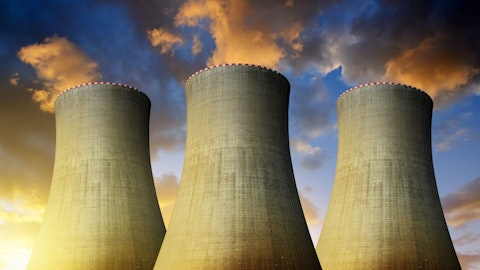Mark Duff: Margin percentage will likely be lower because we’re sharing those with Westinghouse and the JV that we put together with Westinghouse. So I would anticipate this to go down. It’s difficult to really — with the waste that we know that’s in inventory in the U.K. and in Europe, where there’s dramatic amounts of waste and inventory at every nuclear facility over there for the most part. And it’s just — it’s difficult to say what the margins would be. It’s not going to be as good as what we’re used to over here but it should be much less. So I would anticipate 50% to 70% margins on the waste treatment over there.
Ross Taylor: Well, you talk about the number of opportunities and the sizing in the uranium mine, all the uranium mines, like in New Mexico in the Navajo projects. How big are those? How many are they? How long — now that they’re starting, how long do we think they actually will continue to run?
Mark Duff: Some unofficial numbers, Ross. There’s 500 abandoned uranium mines in the country from what EPA has told us, 250 of those are funded for or slated for remediation. At least $1 billion of funding and close probably closer to $2 billion identified for this. But the contract that we have with our teaming partners is a $225 million IDIQ. So there’s 2 other bidders, there are 2 other contingencies — or excuse me, 2 other consortiums of companies that can bid on the task orders. And the value, that’s $225 million which is just about, I want to say, 2 years left on it. And that kind of gives you a sense of the near-term revenue we’re talking about between those 3 companies. Their intention is to get rolling in the field.
There’s enough work to go around for everybody. I’m sure they’ll split it up and they’ll make sure people stay in the field and keep going because these mines are everywhere. They’re painful deal with them; difficult to work, very difficult, very remote, very hot, obviously, dry and difficult conditions. So once you’re out there with your team and people, you don’t want to keep moving in and out, you want to keep going. So that’s our hope there. And that we see this whole program accelerate in visibility and funding and procurement wise, get more task orders out so we can keep going.
Ross Taylor: And same idea, you guys are currently finishing up a job with the Navy in Virginia. I think actually right next door to the Enterprise, if I recall correctly. And the Navy has obviously the Enterprise but it also has a number of other warships that need to be decommissioned in that. What would you be thinking not just we got obviously upcoming soon, the Enterprise, you wanted to queue on that? Is that kind of the same setup with all these other opportunities that the Navy has? And should we see more than just the Enterprise let out this year?
Mark Duff: There’s another building that we’re bidding on right now, it’s due next week I think at the Norfolk Naval Shipyard right next to the ship that we’re decommissioning. So there’s some other ones, other projects are coming out which reflect a new era with the Navy, where they used to just self-perform all this work, now they’re outsourcing it commercially. And that really opens up the market for companies like ours. But to answer your question, the Nimitz is anticipated to be 1 year behind the Enterprise. And the GAO put a report out, I want to say, in ’21 that said that there’s 48 ships to be decommissioned by the Navy in the next 5 years. I think they kind of lost a couple of years because of COVID. Of those 48 ships, I believe there’s about a dozen nuclear ones.
So they have a list. And I haven’t seen the other names below the Enterprise and the Nimitz. The Nimitz is also an aircraft carrier about the same size or as far as difficulty goes. And we expect the Nimitz to come out right after the Enterprise gets awarded.
Ross Taylor: Okay. Well, great. Congratulations. It looks to me like what you’re really talking about is there’s so much opportunity here. We’re just sitting on a clock or a calendar front. It’s really — every day that goes by or a day closer to the tremendous earnings power you’re talking about being unlocked. It’s not really a question of this, it’s just a question of can we be patient enough to get done in the next year or so.




